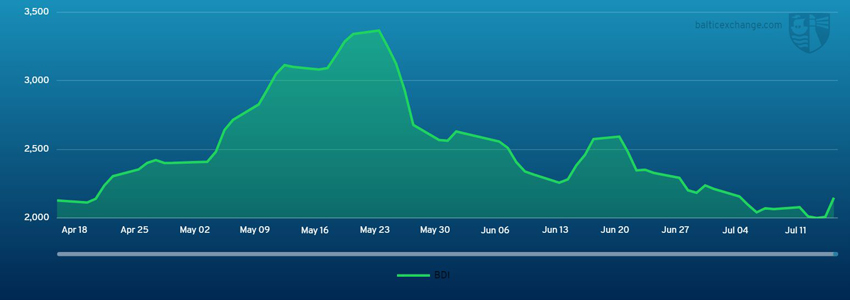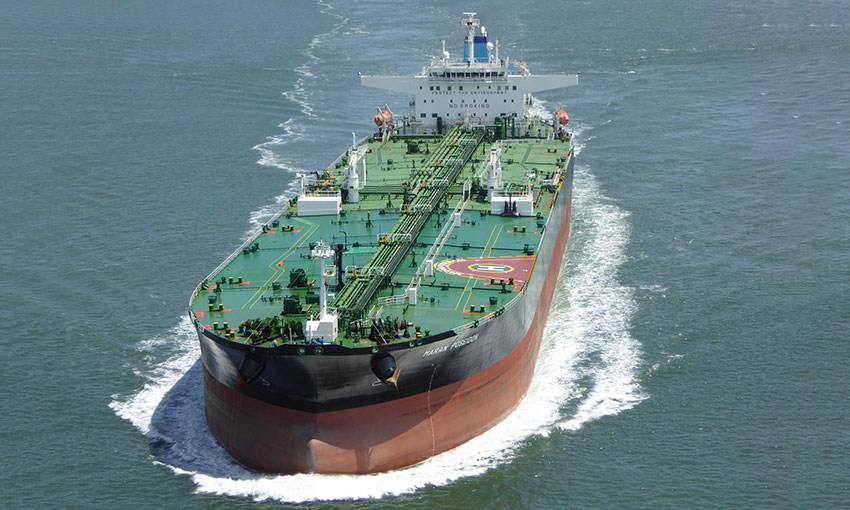THE Baltic Dry Index ended last week at 2150 after a climb from 2067 on the previous Friday. The index dipped slightly in the middle of the week, hitting a nadir of 2002 on Wednesday. It went up to 2010 on Thursday and rocketed to 2150 on Friday.

Capesize
Firmer sentiment across both basins pushed the Capesize 5TC route average above the US$20,000 threshold this week, closing at US$24,209.
Activity in the Pacific gradually picked up midweek after a public holiday in Singapore on Monday. The West Australia to Qingdao iron ore trade climbed closer to US$11, with fixtures reported at better rates towards the end of the week.
Meanwhile, the market saw a lowering of vessels in ballast able to make end July dates – or even early August – loading in Brazil. Quite a few cargoes from Brazil and West Africa were fixed to Qingdao, with a China-Brazil round trip paying nearly US$20,000 per day.
In the North Atlantic, rates roared on both transatlantic and fronthaul trips. The latter remained as the most rewarding route pricing at US$53,611 to perform a run from Continent/Mediterranean to the Far East.
Panamax
The Panamax market provided further losses this week and is showing little signs of abating. Despite a steady level of activity, this failed to stem the tide with both basins yielding significant losses.
The Atlantic saw rates erode for a further successive week, as pressure from the nearby and committed ships continued to underpin the market. From East Coast South America, the focus this week was on end July arrival with APS load port rates now hovering around the US$20,000 + US$1,000,000 mark, but continued to ease throughout the week.
Asia similarly witnessed another week of falls. Again a lack of demand on the longer round trips added further pressure to an already weak market. There were reports midweek of a 75,000-dwt delivery Japan achieving US$16,000 for a NoPac round trip, but activity remained light as the market drifted. Like previous weeks, older and smaller units tended to soak up much of the limited Indonesia demand.
Ultramax/Supramax
Sentiment waned in most areas, with the exception being from the US Gulf. Rates remained relatively firm from there for both runs to the Pacific and within the Atlantic. Limited fresh enquiry elsewhere saw a build up of tonnage leading to downward pressure on rates.
Little period cover was heard, but a 64,000-dwt open China was heard to have been covered US$24,000 for one year.
In the Atlantic, from East Coast South America, a 63,000-dwt was heard fixed at US$18,000 plus US$800,000 ballast bonus for a trip to China.
From the US Gulf a 58,000-dwt was heard fixed delivery SW Pass redelivery Turkey in the mid US$30,000s.
There was a good supply of prompt tonnage in the Asian arena, with a 56,000-dwt open Indonesia now seeing in the low US$20,000s for trips to China.
Backhaul demand eased as well. However, a 63,000-dwt open Dafeng mid-July was heard fixed via Taiwan redelivery Continent with steels at around US$30,000.
Handysize
East Coast South America made positive gains over the week with sources citing a lack of tonnage for end July as the main driving force.
A 38,000-dwt was heard to have been fixed for a trip from South Brazil via River Plate to Morocco at US$30,000. A 28,000-dwt open in Rio Grande fixed via River Plate to Greece at US$22,000.
The Mediterranean was also more active. A 35,000-dwt fixed from Çanakkale via Black Sea to Tunisia at US$16,000.
In Asia, activity had been limited and sentiment remained soft. A 38,000-dwt was rumoured to have been fixed for a trip from CJK via Indonesia to Japan at US$21,000 and a 40,000-dwt fixed from Lanshan via Japan to New Zealand at US$15,000 with a cargo of cement.
Clean
In the Middle East Gulf this week both the LRs and MRs look to have plateaued and show signs of returning upwards at the time of writing. TC1 levelled off at WS200 and has started to tick up again, currently pegged at WS203.57 (+WS1.78). In the market, WS202.5 is widely reported on subjects multiple times at present. TC5 bottomed out at WS285 midweek and has then ticked up five points to WS290, returning US$38k /day round trip TCE. On the MRs TC17 stopped declining at just over WS450 in the middle of the week and since then returned up to WS460.
In the West the LR2s of TC15 saw a widely reported fixture at US$3.875m midweek, leading the index to climb. It currently sits at US$3.879m (+US$129k). On TC16 the LR1s have held around the mid WS230s all week, still returning US$35k/day round trip TCE.
On the UK-Continent the MRs were much busier this week. However, there was plenty of available tonnage to prevent rates from rising sharply. TC2 rose an incremental 2.78 points to WS315.28 (US$29.1k /day round trip TCE) and TC19 followed suit holding around WS325 all week.
The US Gulf MR market saw a further downturn this week with a major correction in rates stemming from a fixture midweek. TC14 has dropped to WS185 (-WS50) and TC18 has similarly dipped WS49.16 to WS286.67 (US$28.6k/day round trip TCE). The MRA TCE dropped from 43,654 to 35,447. On the Handymax, TC6 has continued on a downward trajectory this week, loosing another WS35 to end up at WS273.75 by the end of the week. In the Baltic, TC9 has continued along at around WS510 this week and the round trip TCE still remains a touch over US$60k /day.
VLCC
VLCC rates stayed on an upward trend. 270,000mt Middle East Gulf/China rates gained another point to WS58 (a round-trip TCE of minus US$700 per day). Meanwhile, the 280,000mt Middle East Gulf/USG (via Cape of Good Hope) trip is maintained at WS33 again. In the Atlantic, rates for 260,000mt West Africa/China rose by a solitary point to WS58.5-59 level (about US$2,000 per day round-trip TCE) and the US Gulf export volumes continue to provide optionality for owners, with cargoes to the East and to Europe. The rate for the 270,000mt US Gulf/China voyage jumped another US$262,500 to just shy of US$7.2 million (a round-trip TCE of just above zero per day).
Suezmax
Rates for 135,000mt Black Sea/Augusta recovered the recent lost ground, gaining eight points to a fraction below WS134 (a round-trip TCE of US$34,700 per day). The 130,000mt Nigeria/UKC route was boosted 14 points to between the WS127.5/130 level (a round-trip TCE of US$30,000 per day). In the Middle East, the rate for 140,000mt Basra/West Mediterranean jumped 20 points to WS77.5 having started the week at mid-WS50s and a handful of charterers covering the remaining July stems with the rate on each fixture higher than the last.
Aframax
The Mediterranean market slowly started to recover and the rate for 80,000mt Ceyhan/West Mediterranean climbed seven points to almost WS170 (a round-trip TCE of about US$32,200 per day). In Northern Europe the rate for 80,000mt Hound Point/UK Continent, having gained almost 60 points within the last 11 days or so, peaked at WS211 and has now eased back to WS201.5 (a daily round trip TCE of US$59,500). For the 100,000mt Primorsk/UK Cont route, rates have firmed again and are up 25 points week-on-week at WS241.5 (a round trip TCE of close to US$78,400 per day). Across the Atlantic, rates appear to have peaked and are now coming off. Rates for the 70,000mt EC Mexico/US Gulf route steadily climbed to WS315, and have been last assessed on Thursday at WS301 (a round-trip TCE of US$68,300 per day), two points higher than a week ago. The 70,000mt Caribbean/US Gulf trip similarly rose 25 points to almost WS300 early in the week, but have now fallen back to WS282.5 (a round-trip TCE of about US$56,200). For the transatlantic trip of 70,000mt US Gulf/UK Continent, rates improved by 32.5 points to WS245 but have now slipped to WS222.5 (US$36,300 per day round-tip TCE).

